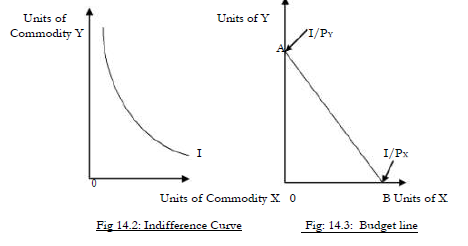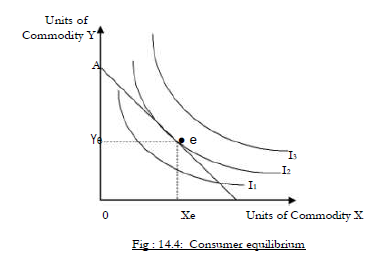Consumer equilibrium under the ordinalist approach:
Consumer equilibrium refers to a specific point in consumption of (two) goods from which the
consumer derives maximum satisfaction subject to a given budget constraint (determined by the
consumer?s income and commodity prices).
This equilibrium point is achieved at the point of tangency of a budget line to the highest possible
indifference curve; at this point, the slope of the indifference curve (i.e. marginal rate of substitution
– MRS) is equal to the slope of the budget line (i.e. relative commodity prices) Thus, at
equilibrium MRSxy = Px/Py.
Indifference curve – defined as the locus of possible combinations of two commodities their
consumption from which the consumer derives the same level of satisfaction. Such curves are
negatively sloped, do not intersect and convex to the origin.
Budget line – refers to the locus of combinations of two goods whose purchase exhausts the
consumer?s budget constraint (money outlay).

At the point of tangency, the consumer is said to be in equilibrium as shown below:

Point (e) is consumer equilibrium point where the slope of the budget line (AB) (Px/Py) is equal to the slope
of the indifference curve (I2) (MRSXY) with Xe of X and Ye of Y. The indifference curve (I2) has its maximum
convexity at point (e) denoting diminishing marginal rate of substitution.
The indifference curve (I1) is attainable but inefficient since it does not maximize satisfaction, that is,
consumer?s income is not fully utilized. Similarly, indifference curve (I3) is NOT attainable with the
presentlevel of income and commodity prices.
It is therefore at the point of tangency (e) that the consumer maximizes satisfaction by fully spending the
disposable income on Xe of X and Ye of commodity Y, given the prices of X and Y.
Wilfykil answered the question on
February 6, 2019 at 06:46